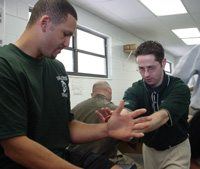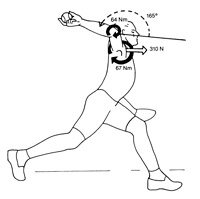Long toss programs have become one of the most popular forms of baseball training over the last several years. It seems like everyone on the internet has a long toss program that guarantees to increase your pitching velocity. The number of youth pitching injuries continues to increase at alarming rates, despite our pitch count guidelines and improved medical knowledge. This has caused some to question the role of aggressive long toss programs on the increased rate of injuries, which may or may not be fair, as there are many different ways of integrating long toss training programs.
The intent of this article is not to offer an opinion on whether or not long toss is appropriate, safe, effective, or anything else. The purpose is not to recommend a specific throwing program or distance either. Rather, I simply want to make sure you completely understand what long tossing does to your body before you start a training program. There are several things you need to understand to best implement a program that is specific to your needs.
Long Toss is Important
Let’s get this point out of the way first – long toss programs are important. I don’t think this is much of a debate as long toss, in some form, is a normal part of almost every baseball training program. Saying you do or do not like long toss is like saying you do or do not like Pizza. There is a large difference between Dominos pizza and something from Boson’s North End. Same goes for long toss. How you define long toss is probably more the debate.
Some consider 120 feet long toss, while others will say over 300 feet. That is a big difference. I don’t know the answer but I know that things change the further you throw. You need to understand this too.
While long tossing is important, it is also often blown out of proportion. People that are advocates of long toss programs will excitedly tell you which big leaguers utilize long distance long toss programs in their training. But realize there are also plenty of professional baseball players that do not incorporate a lot of long toss into their routines. I know many big leaguers who do not often throw more than 120-150 feet, and I’ve talked to many that live in colder climates and throw indoors in places like basketball courts all offseason, limiting the distance they can throw.
I only bring this up because I hear from many of my patients and clients about all these great MLB players that long toss, and while that is true, just realize there are many that do not.
I think long tossing is important to help get the arm in shape and accustomed to developing and dissipating forces. But you really need to understand many of the points below to truly appreciate what long toss does to your body.
Long Toss Does Not Increase Arm Strength
I’m not really sure where the concept of long tossing developing “arm strength” came from but it certainly is common. This may just be a garbage term that is thrown out there, or just an easy term to relate to the player, but to be clear and specific, I actually think throwing DECREASES arm strength.

So I think it is safe to say that throwing doesn’t increase arm strength. Rather, it may actually be counterproductive for arm strength as throwing seems to fatigue the shoulder. Long tossing may improve something else, such as muscular endurance or arm speed, but there is a fine line between building speed and endurance and overloading and causing fatigue. If you cumulatively fatigue the arm, you will get strength loss, not gain, and put yourself at risk for injury.
This is an important concept to understand as young baseball players are hearing that long toss increases velocity and assuming that the more they long toss, the harder they will throw. This is resulting in more throwing over the course of the year. Now young baseball players are competitively pitching and then long tossing both during the inseason and offseason. Remember that pitching for more than 8 months out of the year increases your chance of getting injured by 5x!
There is a place for long toss, but it does not build arm strength. To build arm strength you need downtime from throwing and good arm care and strength and conditioning programs.
The Rehab World Does Not Say Stop at 120 Feet During Long Toss Programs
I’m going to take the blame for this one. One of the most common disputes I hear from advocates of long toss programs is that throwing to 120 feet isn’t long enough. I’ve heard and read many people criticize the baseball community for applying the same long toss programs for healthy players and players returning from injury, citing the that the published rehab throwing programs stop at 120 feet.
This is actually a misunderstanding and I speak from experience. I actually helped develop the most popularly utilized long toss rehabilitation programs used by Dr. James Andrews and I published these programs in the Journal of Orthopedic and Sports Physical Therapy over a decade ago. If you actually read the manuscript, you’ll see that I don’t say that throwing programs should stop at 120 feet. In fact, the program actually goes out to 180 feet.
We simply state that you need to throw out to 120 feet before meeting the criteria to begin throwing off a mound. Some players will want to go past 120 feet (and should), while others will not. The point is, you don’t have to throw past 120 feet but in order to progress to throwing off a mound, long tossing to 120 feet is just one of the criteria.
Now I readily admit that these published long toss programs are not perfect, and I in fact do not quite follow these programs as I wrote myself. You see, it’s hard to develop a long toss program that is applicable for everyone. A certain amount of generalization needs to occur in the rehabilitation setting. We’ll talk more about this in my last point below.
Long Toss Does Not Promote Proper Pitching Mechanics
It is really impossible to use consistent pitching mechanics when long tossing. This is just simple physics. I’m not sure how people can state that long tossing helps with your pitching mechanics as you need to throw differently the further you go. Glenn Fleisig and the American Sports Medicine Institute recently analyzed the difference in mechanics between pitching off a mound and long tossing at 120 feet, 180 feet, and at maximum distance.
This study revealed significant mechanical changes during long toss. You are not throwing downhill, like on a mound. In fact you are actually throwing uphill, as your trunk is more upright and your front knee is less flexed the further you go back. Your upper trunk angle actually quadruples from pitching to throwing max distance.
These both have implications on throwing as your more upright position will change your trunk and front side’s contribution to throwing and your release point will vary dramatically.
Also, of interest is that you land with your foot position more open the further you throw. Essentially, you long toss more on a line than slightly across your body (which is normal). To me, this implies you need to have less rotational motion to throw the ball for maximum distance. You essential throw more like a ferris wheel than a carousel when you long toss, which utilizes different muscle recruitment patterns and motor planning from when you pitch.
So in light of all our recent research on motor control, neuromuscular planning, and specificity of training, it would appear long tossing does not support improving your mechanics.
I know from my experience with elite level pitching that your ability to repeat your mechanics over and over again is one of the most sought after skills and something the separates the elite from everyone else. Remember my first point above, long toss is important, but it is not because it helps with your mechanics or encourages repeating your delivery.
The Longer you Throw the More Stressful it is on Your Body
When our long toss programs were originally being developed, one of the first questions that we sought to answer was what happens to the forces on your body as you throw from certain distances. We know from the above information that you have kinematic changes, but what about the kinetic forces on the body? Dr. Fleisig also looked at the forces observed on the body in the above mentioned study.

We know that pitching a baseball places near maximal stress on the body with each pitch. Long tossing to 180 feet and beyond increases this stress more than pitching off a mound. This is one of the main reasons that the criteria for an injured player to start throwing off the mound is only 120 feet. At 120 feet, the forces observed are similar to pitching. So if you can throw to 120 feet, you can technically handle the stress of throwing off a mound.
Athletes can handle the stress observed during long tossing to 180 feet and beyond, but for how long and at what consequence? I had a discussion with Dr. Fleisig and Dr. Andrews about this concept and the analogy that was used was rather alarming – You can observe a group of Little League aged kids smoke a pack of cigarettes a day and none of them will likely get lung cancer while in Little League, but they may one day. What are we doing to them in the long-term?
Realize that the pitch count guidelines that were developed by Little League and USA Baseball are designed to prevent injuries by avoiding overuse. Long toss to 180 feet and beyond needs to be included in this equation as well. If you want to decrease you chances of getting injured by 5x, you need to not pitch or long toss for 4 months out of the year.
There is a time and place for long toss, but this needs to be treated like pitching and considered in the overall equation for overuse.
Maximum Distance Long Tossing is Stressful on Your Body
To me, the most interesting part of the studies from Dr. Fleisig and ASMI is when they analyzed maximum distance long tossing. In addition to analyzing how your biomechanics change as you throw from certain distances, they also assess the biomechanics of simple throwing as far as you can.
The results were staggering.
When asked to throw as far as they could, with a crow hop and with no restrictions on the amount of arc on the throw, pitchers averaged a throw of 264 feet, far below the recommendations seen in some baseball training programs.
This resulted in a 10% increase in both elbow varus torque and shoulder internal rotation torque. So while long tossing to 180 feet showed an increase in torque to your shoulder and elbow, these forces went up dramatically when throwing for maximum distance.
There is a risk / reward equation with long tossing to 180 feet, but this equation appears to heavily lean towards the risk when throwing further.
The Best Baseball Long Toss Program
I wrote this article for one simple reason – there is no such thing as the best baseball long toss program. Everyone wants one, but it just doesn’t exist. Everyone is different, including their body type, size, age, experience, and mechanics. Recommending one generic long toss program for everyone seems overly simplified. While it may help a small percentage of people, it appears that it could harm a much larger percentage. That is why the rehab throwing programs I published seem so basic.
Now that you understand some of the finer points of long toss programs, I hope this allows you to understand that the best long toss program needs to be individualized. You shouldn’t be doing a program just because some big leaguer is doing it, you should be doing it because it has been specifically developed for you in combination with a well designed arm care and strength and conditioning program.
To follow this up, I will write an article soon on what I believe long toss is actually doing and why it may be beneficial to include in baseball training programs, if designed appropriately.
[hr]





